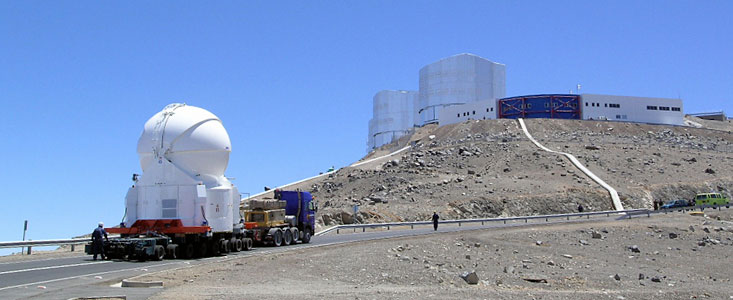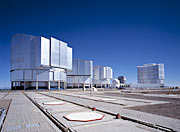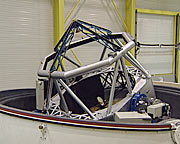Lehdistötiedote
First Auxiliary Telescope for the VLT Interferometer Installed at Paranal
World's Largest Moving Optical Telescope on Track
30. tammikuuta 2004
Another advanced astronomical telescope has just been installed at the Paranal Observatory, located in the heart of the Chilean Atacama Desert and home of the ESO Very Large Telescope (VLT). The new telescope, known as Auxiliary Telescope no. 1 (AT1), forms part of the VLT Interferometer (VLTI). It has a main mirror of 1.8-m diameter and is installed in a compact dome. In contrast to the four giant 8.2-m telescopes and, indeed, to any other telescope in the world of this size, it can be moved along a system of railway tracks on the top of the Paranal mountain. It sends the captured light from celestial objects into the subterranean Interferometric Tunnel from where it is directed to the central Interferometric Laboratory. This is the first of four AT's that will be installed in 2004-2006. These compact, high-tech telescopes are built by the AMOS company in Liège (Belgium). When placed in different configurations on the tracks, they will enable the VLTI to operate with great flexibility (also when the large telescopes are busy with other observations) and to obtain extremely sharp images of celestial objects - ultimately with a resolution that corresponds to seeing an astronaut on the Moon.
Auxiliary Telescope No. 1 (AT1)
European astronomers and engineers are opening a new chapter in the story of astronomical research and technology, by testing a new type of telescope at the ESO Paranal Observatory in Chile, the world's leading facility for ground-based optical astronomical research. This new telescope is not particularly big. In fact, the telescope mirror that catches the starlight is only 1.8-m in diameter. So why is this telescope so important?
With three sister telescopes yet to be installed, it constitutes a key element of the so-called Very Large Telescope Interferometer (VLTI) , arguably the world's most advanced optical device of this type. An interferometer of this size will allow scientists to study suitable objects in unprecedented detail, with a resolution up to 50 times better than the Hubble Space Telescope.
The VLT Interferometer
The VLTI incorporates the four gigantic 8.2-m telescopes that have already been installed at this remote mountain observatory and are operated every night in the year. Combining the light from the celestial objects, caught by pairs of these telescopes, at one focal point increases the resolving power of the instrument.
However, most of the time the large telescopes are used for other purposes. They are therefore only available for interferometric observations during a limited number of nights every year. Thus, in order to exploit the VLTI each night and to achieve the full potential of this setup, some other (smaller), dedicated telescopes are necessary.
These telescopes, known as the VLTI Auxiliary Telescopes (ATs) are mounted on tracks and can be placed at precisely defined "parking" observing positions on the observatory platform. From these positions, their light beams are fed into the same common focal point via a complex systems of reflecting mirrors in an underground system of tunnels.
The possibility to move the ATs around and thereby to perform observations with different telescope configurations ensures a great degree of flexibility. Moreover, due to the nature of interferometry, more complete images of the celestial objects will be observed with the ATs. While the largest possible distance between two 8.2-m telescopes (ANTU and YEPUN) is about 130 metres, the maximal distance between two ATs can reach 200 metres. As the achievable image sharpness increases with the telescope separation, interferometric observations with the ATs positioned at the extreme positions will yield sharper images than is possible by combining light from the large telescopes alone.
The ATs are very unusual telescopes
The Auxiliary Telescopes have rather unusual characteristics:
- they are relocatable;
- they are totally self-sufficient with only electrical connections to the site;
- they carry their own dome and cooling and ventilation systems and do not need additional environmental protection;
- they must fulfil the very stringent mechanical stability requirements imposed by interferometry at the level of a few tens of nanometres.
Since the new ATs are moveable, the entire configuration of telescopes can be changed according to the observational requirements.
Classical telescopes of this size are housed in huge buildings with big domes. The ATs, however, are placed in ultra-compact enclosures, complete with all necessary electronics, air conditioning system and cooling liquid for thermal control, compressed air for enclosure seals, hydraulic plant for opening the dome shells, etc. Each AT is also fitted with a transporter that lifts the telescope and moves it from one station to the other. Almost like a snail, it moves around with its own housing.
At the same time, they must fulfil very stringent mechanical stability requirements imposed by interferometry. Moreover, moving ultra-high precision telescopes, each weighing 33 tonnes, without spending days or even hours to re-adjust them after each move puts exceedingly high demands on the mechanical design and manufacturing.
AT1 at Paranal
After a busy installation period lasting two and a half months, the first of the four ATs, AT1, is now in place at Paranal. To get this far has not been easy. It has been a daunting task, drawing on the innovative skills both of the ESO team of engineers and of the Belgian company, AMOS, that was entrusted with the construction.
Bertrand Koehler, the VLTI AT Project Manager, is pleased and relieved at the same time : "We are living in a very significant moment in the life of this project. It is in some way the birth of the first of four twins, belonging to a whole new generation of telescopes, the VLTI Auxiliary Telescopes. The numerous tests made in Europe and now here in Chile, have proven that the baby is in good shape. This is of course the result of five years of hard labour by engineers, scientists and technicians belonging to European industries and to ESO ."
ESO's Director General, Dr. Catherine Cesarsky, was at Paranal during the final phases of the installation of AT1: "At Paranal, in the Atacama Desert, we have created a hi-tech heaven to which we are now bringing this new telescope, the first Auxiliary Telescope. It is itself a jewel and in some ways it might even be considered more modern than the VLT itself. We had to conceive a totally new solution to a new problem, that is, to make a telescope that is able to carry all its systems with itself, and we succeeded! I don't think this has ever been done before."
A bright future for the VLTI
The installation of Auxiliary Telescope 1 at Paranal is another important step during the progressive implementation of the unique VLT Interferometer. More ATs will be added, and soon more instruments to capture and measure the light at the interferometric focus will be installed.
Optical interferometry on the scale that ESO is aiming for is an enormous technical challenge, but the reward is high. With its unrivalled ability for resolving details of astronomical objects, European astronomers will ultimately have an instrument at their disposal that may revolutionize many areas of astronomical research.
Information for the media
This Press Release is accompanied with ESO Video News Reel no. 14 (30 January 2004). It will appear on "Europe by Satellite" (EBS) on this and the following day. nical design and manufacturing.
Tiedotteesta
| Tiedote nr.: | eso0402 |
| Legacy ID: | PR 01/04 |
| Nimi: | Auxiliary Telescopes, Very Large Telescope, Very Large Telescope Interferometer |
| Tyyppi: | Unspecified : Technology : Observatory : Telescope |
Our use of Cookies
We use cookies that are essential for accessing our websites and using our services. We also use cookies to analyse, measure and improve our websites’ performance, to enable content sharing via social media and to display media content hosted on third-party platforms.
ESO Cookies Policy
The European Organisation for Astronomical Research in the Southern Hemisphere (ESO) is the pre-eminent intergovernmental science and technology organisation in astronomy. It carries out an ambitious programme focused on the design, construction and operation of powerful ground-based observing facilities for astronomy.
This Cookies Policy is intended to provide clarity by outlining the cookies used on the ESO public websites, their functions, the options you have for controlling them, and the ways you can contact us for additional details.
What are cookies?
Cookies are small pieces of data stored on your device by websites you visit. They serve various purposes, such as remembering login credentials and preferences and enhance your browsing experience.
Categories of cookies we use
Essential cookies (always active): These cookies are strictly necessary for the proper functioning of our website. Without these cookies, the website cannot operate correctly, and certain services, such as logging in or accessing secure areas, may not be available; because they are essential for the website’s operation, they cannot be disabled.
Functional Cookies: These cookies enhance your browsing experience by enabling additional features and personalization, such as remembering your preferences and settings. While not strictly necessary for the website to function, they improve usability and convenience; these cookies are only placed if you provide your consent.
Analytics cookies: These cookies collect information about how visitors interact with our website, such as which pages are visited most often and how users navigate the site. This data helps us improve website performance, optimize content, and enhance the user experience; these cookies are only placed if you provide your consent. We use the following analytics cookies.
Matomo Cookies:
This website uses Matomo (formerly Piwik), an open source software which enables the statistical analysis of website visits. Matomo uses cookies (text files) which are saved on your computer and which allow us to analyze how you use our website. The website user information generated by the cookies will only be saved on the servers of our IT Department. We use this information to analyze www.eso.org visits and to prepare reports on website activities. These data will not be disclosed to third parties.
On behalf of ESO, Matomo will use this information for the purpose of evaluating your use of the website, compiling reports on website activity and providing other services relating to website activity and internet usage.
Matomo cookies settings:
Additional Third-party cookies on ESO websites: some of our pages display content from external providers, e.g. YouTube.
Such third-party services are outside of ESO control and may, at any time, change their terms of service, use of cookies, etc.
YouTube: Some videos on the ESO website are embedded from ESO’s official YouTube channel. We have enabled YouTube’s privacy-enhanced mode, meaning that no cookies are set unless the user actively clicks on the video to play it. Additionally, in this mode, YouTube does not store any personally identifiable cookie data for embedded video playbacks. For more details, please refer to YouTube’s embedding videos information page.
Cookies can also be classified based on the following elements.
Regarding the domain, there are:
- First-party cookies, set by the website you are currently visiting. They are stored by the same domain that you are browsing and are used to enhance your experience on that site;
- Third-party cookies, set by a domain other than the one you are currently visiting.
As for their duration, cookies can be:
- Browser-session cookies, which are deleted when the user closes the browser;
- Stored cookies, which stay on the user's device for a predetermined period of time.
How to manage cookies
Cookie settings: You can modify your cookie choices for the ESO webpages at any time by clicking on the link Cookie settings at the bottom of any page.
In your browser: If you wish to delete cookies or instruct your browser to delete or block cookies by default, please visit the help pages of your browser:
Please be aware that if you delete or decline cookies, certain functionalities of our website may be not be available and your browsing experience may be affected.
You can set most browsers to prevent any cookies being placed on your device, but you may then have to manually adjust some preferences every time you visit a site/page. And some services and functionalities may not work properly at all (e.g. profile logging-in, shop check out).
Updates to the ESO Cookies Policy
The ESO Cookies Policy may be subject to future updates, which will be made available on this page.
Additional information
For any queries related to cookies, please contact: pdprATesoDOTorg.
As ESO public webpages are managed by our Department of Communication, your questions will be dealt with the support of the said Department.







